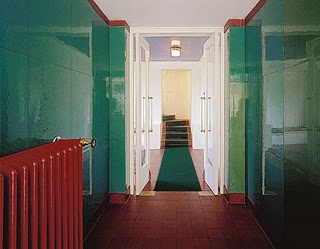The drawings took a long time to complete, simply because of the size and amount of detail in the house. I was fairly happy with the result but think that the use of heavier / lighter lineweights would have given a greater contrast. I would probably choose to hand draw them if I could do it again, simply because I think more expression could be added with ink, as opposed to CAD.
In my analysis, I've tried to show three things: public space (bold lines), private spaces (fine lines) and corridors / circulation routes (grey hatch). The lift is shaded black. These were designed to emphasise the following points:
- Each space is connected to others, providing multiple options by which to circulate
- Corridors and stairs are located mostly toward the interior of the building, and usually travel pass the public areas to reach the private areas.
- The upper level (or bedroom level) is exclusively private space
- The cubic nature of all of the rooms
The analysis on the second poster shows the cubic layout from a sectional view. Rooms are highlighted with a heavier line, whilst corridors in between are lighter. Here we can see the level changes, room heights and the contrast between these and the slope of the site. When each level is layered on top of the other, it demonstrates how the general height and level of rooms decrease from the outside toward the inside, almost as though the space closes in as you draw closer to the centre of the villa.



















